In-Depth
Office 365 Review: You Get What You Pay For
With its much-anticipated suite, Microsoft is providing solid value at many different price points. The Office suite subscription option, especially, should jumpstart a lot of customer conversations.
When you put the word "Office" in front of any product coming out of Redmond, folks that aren't in-the-know are bound to assume it's the next flavor of the Office suite. I cannot tell you how many people have asked me when Word 365 was being released. Let's put this one to rest at the outset: Office 365 is not a new flavor of Office (not yet, anyway -- you never know if the name catches on what Microsoft will do with it going forward).
It is, however, the next generation flavor of the Microsoft Business Productivity Online Suite, which is essentially Exchange, SharePoint and Communications Server (now Lync Server) all being upgraded from 2007 to 2010 (2010 SP1 in the case of Exchange). It is a per-user, per-month subscription plan to these services that allows you to pay-as-you-grow. And there are two ways that the "Office" in Office 365 is a factor. Users can use the stripped-down, browser-based Office functionality known as Office Web Apps to perform light editing of Office documents. Plus, for more money per month, higher-end Office 365 subscriptions allow for monthly fee-based access to the full desktop version of the Office 2010 suite.
That's it. At the core, Office 365 is a re-launched BPOS with some Office options. For those of us who use BPOS, it's an awesome offering just because it takes us to the next release of Exchange, SharePoint and Lync. The benefits in Exchange may be lost on the average Outlook user, who would typically use an Outlook Anywhere or RPC-over-HTTP type connection. But if you connect to your BPOS with Outlook Web App you will be pleased when looking at the 2010 SP1 polished version of Outlook Web App. And for SharePoint users, the polished 2010 Foundations version you'll be using when working with Office 365 will really impress you, no doubt.
The Administrative Side
From an administrative perspective, Office 365 is as easy to work with as any hosted Exchange solution, assuming you have worked with one of these before. Simply put, it requires much less administrative ability than an on-premises deployment of Exchange, SharePoint or Lync.
Microsoft is handling all of the administrative back-end, including the infrastructure, assurance of high availability (backed by a Service Level Agreement) and recoverability. An administrator has the ability to configure Office 365 through the Web interface that has a small subset of the on-premises Exchange configuration options. The biggest worry is creating users, which involves several screens for entering their information, assigning a role and user location, assigning a license and configuring who gets the results e-mail (which includes the user name and temporary password).
The main focus of Office 365 revolves around Exchange and user creation; however, SharePoint administration is also made easy through the administration center, which allows for configuration and management of site collections, configuring InfoPath Forms Services, managing user profiles, managing the term store and more. Lync provides for instant messaging, as well as audio and video online meeting ability, and this also requires some configuration through the Admin Overview dashboard that is provided upon first login (see Figure 1).
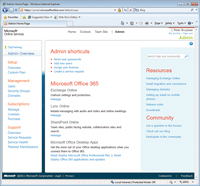
[Click on image for larger view.] |
| Figure 1. The Admin Home Page in Office 365 shows how few tasks remain for administrators to handle in the Office 365 scenario. This view shows a version of Office 365 with Exchange Online, Lync Online, SharePoint Online and Microsoft Office Desktop Apps. |
This review covers the public beta for Office 365 -- general availability was slated to coincide with a Steve Ballmer-hosted launch event in New York City on June 28. However, there are promises of a connection piece coming that will bridge the gap between Office 365 and on-premises Exchange with the release of the second service pack for Exchange 2010. This hybrid co-existence connector is supposedly going to introduce a wizard that will allow mailbox moves and make configuration and management of hybrid environments a bit easier. In addition, Small Business Server 2011 Essentials is also going to have a special connection wizard that will allow SBS admins to easily create and manage user mailboxes that are hosted in the cloud through Office 365.
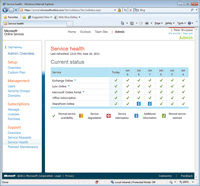
[Click on image for larger view.] |
| Figure 2. A service health dashboard shows the administrator the status of the services an organization subscribes to through Office 365. |
The Plans
You may be wondering: If Office 365 is simply an online or hosted version of familiar on-premises solutions from Microsoft, what is the motivation for relinquishing that administrative control customers have grown accustomed to over the years?
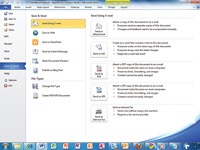
[Click on image for larger view.] |
| Figure 3. Office 365 provides a new way to license the Office suite with Office Professional Plus. |
It's going to come down to three things: price comparison between handling these solutions on-premises and having them handled for you through Office 365; limitations of the Office 365 solution that may be deal breakers for you or your customers; and security concerns or fears internally on placing some of these mission-critical solutions in the hands of another. Because the security and SLA concerns tend to be broader discussions about comfort with the entire category of applications in the cloud or the reputation and capabilities of Microsoft across all of its hosted offerings, we'll focus our attention here on the nitty gritty of the plans.
The Office 365 subscription plans range from $2 to $27 per month. The absolute lowest end versions are for so-called kiosk workers (sometimes referred to by Microsoft as deskless workers in other products). The profile of typical kiosk workers is that they spend less than 10 percent of their time on a PC, share a terminal with other kiosk workers and haven't had access to a corporate mailbox in the past. Organizations can pay $2 per month for Exchange Online Kiosk. The first real Office 365 suite, though, is called Office 365 K1 (K is for kiosk), and it costs $4 and adds SharePoint Online Kiosk to the Exchange offering. The top kiosk suite, K2, is $10 per month and it adds the Office Web Apps capability for editing, rather than just viewing, Office documents in a browser.
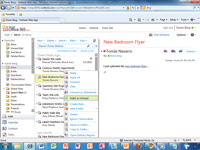
[Click on image for larger view.] |
| Figure 4. The feature parity with Exchange 2010 means Outlook Web App users of Office 365 will be pleased with the polish of the UI. |
Where Microsoft expects to see the most activity is around Office 365 P1, a $6-per-month Office 365 suite for small businesses and professionals. According to Microsoft, about 70 percent of the participants in the first Office 365 beta were small businesses. Designed for one to 25 users, P1 will support workgroups of up to 50 people. It includes Office Web Apps, a 25GB mailbox for each user and Exchange Online, SharePoint Online and Lync Online. There's no option to subscribe to the full Office software package in the small business plan, but the product works with regularly licensed 2007 or 2010 editions of Office.
The group of four plans that brings the most flexibility, and some of the most interesting scenarios, is called the Plan E Family (with E standing for enterprise). Mapping most closely to the current BPOS offering is the E1 plan, which will cost $10 per user per month. It's designed for organizations with more than 50 users that already have Office or don't need the suite or any browser-based Office document-editing capability. Next is E2, which pulls in the Office Web Apps, for a total of $16 per user per month.
Above those two plans are the E3 and E4 versions that include Office Professional Plus. This is a new licensing model from Microsoft in that it provides a pay-as-you-go option for Office licensing. Users get the full version of Office to install on their desktops, but the organization pays for Office on a month-to-month basis through the Office 365 subscription. (In the event that a user's Office 365 account is discontinued, the subscription is cancelled and the already-installed Office goes into reduced functionality mode.) What this means is that every organization will need to pull out their calculator and figure out what the most cost-effective way to license Office is going forward -- a great opportunity for partner consulting engagements with strong customer ROI potential.
The E3 plan, the foundation for the Plan E Family beta, costs $24 per user per month and includes Office Professional Plus, voicemail, advanced archive capabilities, services for Forms, Access, Excel and Visio, and some higher-end Exchange and SharePoint functionality. The $27-per-user, per-month E4 edition adds voice capability, called Lync Plus.
Pay-as-you-go add-on options include SharePoint Online Storage at $2.50 per GB, extranet capability at $2 and BlackBerry support for $10 per user per month.
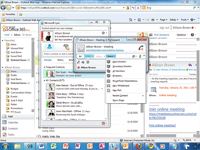
[Click on image for larger view.] |
| Figure 5. Higher-end versions of the Office 365 Plan E Family provide escalating levels of Lync functionality. |
Now, I mentioned there were limitations in the offering. These limitations may, in fact, be deal breakers for your organization and typically it comes down to reading the service descriptions for each product (Exchange/SharePoint and Lync) and looking toward the appendix of each to see a comparison between what you have with an on-site version compared to the online version.
For example, in the various enterprise plans there's a 25GB mailbox storage limitation. That may be plenty for some, but it may not be acceptable for others. There are also message size limitations (max attachment size) of 25MB, recipient limits of 500 recipients per day, and message rate limits of 30 messages per minute. Outlook 2003 is not supported. Neither are Windows Mobile 5.0+ devices (Windows Phone 7 devices are supported). Public folders are also not supported (the direction has been to move those to SharePoint and in the Office 365 world that is the only option). On the SharePoint side many of the features are the same due to the Web-oriented nature of SharePoint to start with; however, there are many search features that are not included with the SharePoint Online offering. Lync Online offers only a small portion of what the on-premises flavor provides.
Again, we were still working with the beta for this review. There's no substitute for going through the documentation on the General Availability version to see which features and functionality made the final cut.
Final Word on Office 365
Usually when I give a final word on a product I like to feel my words are going to be read without bias. The debate over cloud-based solutions has become religious in nature, at this point, so I'll try and cater to all sides here.
I believe Office 365 provides value for enterprise customers looking to do the following:
- Provide a robust and familiar experience for users with regard to communication and collaboration
- Deliver an easy way to upgrade end users to the latest Office platform on their desktops and immediately provide the appearance of a whole infrastructure (but without the pain of having to set up and manage the solution)
- Offer very tight integration with on-premises Exchange, allowing for hybrid deployments that are going to be easy to manage
As you can see, I have not compared the cost to other solutions, such as Google Apps. Cost is always going to be a factor and the question is two-fold: Do you get what you pay for with Office 365? I believe you do. Do you need all that you are paying for? In my case, and the case of many others, I do need and want all of those features. So I feel there is real value to the offering. Every company has different needs. Some customers won't need as robust an offering, nor the price tag that comes along with it. For those customers, another solution -- less polished, perhaps -- may be what they need.
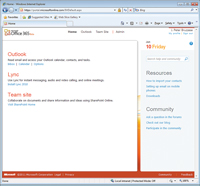
[Click on image for larger view.] |
| Figure 6. View of the basic Office 365 UI for end users. |
Then there are those who are adamant about maintaining their own infrastructure. That is a religious viewpoint at heart. "I was born an in-house infrastructure admin and I'll die an in-house infrastructure admin!" they bellow. Well, those of us who want to stay employed in the 21st century are going to be a bit more open-minded about cloud-based infrastructure, platform and services. Again, the hybrid capabilities of Office 365 give you a chance to keep your on-premises solution while getting your feet wet in the cloud.
So, is Office 365 the be-all, end-all of hosted communication and collaboration? Price aside, based solely on features and polished look and feel, I'd say absolutely. Bringing price into the picture, I'd say it depends on the needs of your company or customer. But I believe Microsoft has given us something of value for the price tag and a lot of price tag/feature bundles to match many different requirements.
The only real negative in this discussion are the limitations found in the service descriptions. I understand the reasoning behind some of the size limits and missing features but when comparing on-premises to cloud solutions there will be some who will be able to say "see, they aren't exactly equal." The more equal they are, the easier it is to debate the move to a cloud-based solution over on-premises.
In the end, you're just going to have to consult with your customers on whether Office 365 is all that they're looking for within their environments.
More Office 365: